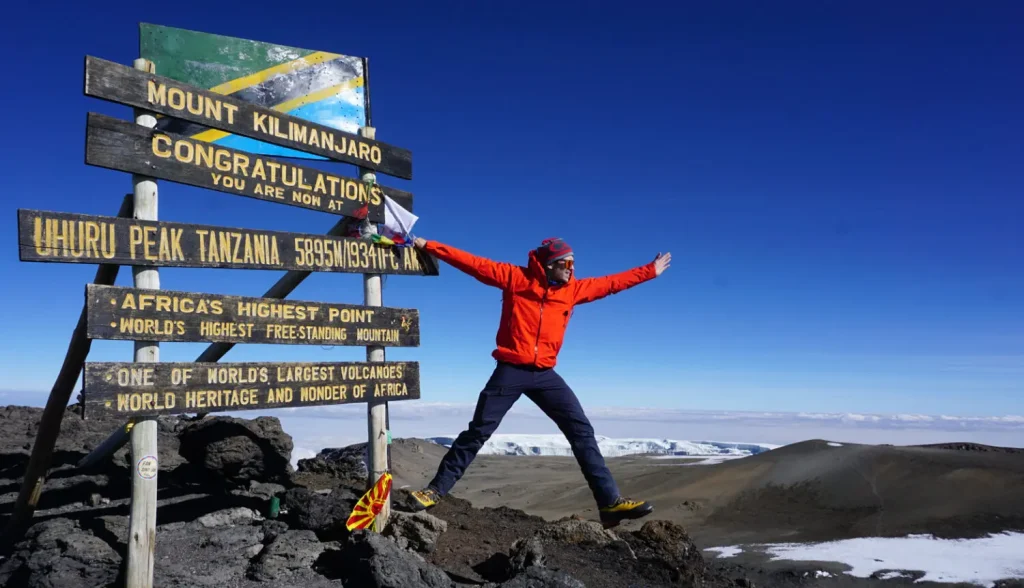Call +255 783 884 129
Climbing Mount Kilimanjaro is one of the most incredible adventures you can experience, but it is also a challenge that demands the right clothing. The mountain has five distinct climate zones, each with its own temperature and weather patterns. You will start your trek in the warm, humid rainforest and gradually move through heath, moorland, alpine desert, and finally reach the freezing arctic summit zone. This means that the clothing you choose, especially your jackets and layers, can make the difference between a comfortable, enjoyable climb and a miserable one. Understanding how to layer properly and which jackets to bring will help you stay warm, dry, and safe all the way to the top.

When preparing for Kilimanjaro, it is important to think about your clothing in terms of layers. Layering is the system of wearing several garments on top of each other so you can adjust your warmth and protection depending on the weather and activity level. The three main layers are the base layer, mid layer, and outer layer. Each has a specific function, and all are essential.
The base layer is the clothing that touches your skin. Its main job is to keep you dry by wicking away sweat. Kilimanjaro trekking can be intense during the day, and if your sweat stays on your skin, you will quickly feel cold when you stop moving. Choose a base layer made from moisture-wicking fabrics like merino wool or synthetic materials. Avoid cotton at all costs because it holds moisture and will make you feel cold and damp.
The mid layer is your insulation. This is the layer that keeps you warm by trapping body heat. Fleece jackets or lightweight down jackets work perfectly for this stage of the climb. In the lower sections of Kilimanjaro, you may not need much insulation, but as you climb higher, especially above 3,500 meters, the temperatures drop sharply. You will often wear your mid layer in camp during the evenings and early mornings when it is cold.
The outer layer is your protection against wind, rain, and snow. On Kilimanjaro, weather can change quickly, and even on a sunny day, you can encounter sudden downpours or strong winds. A high-quality waterproof and windproof shell jacket is essential. This should be lightweight but strong, with a hood that can fit over your hat and adjustable cuffs to keep out cold wind. Gore-Tex or similar breathable waterproof materials are excellent because they keep you dry from both rain and sweat.
One of the most important jackets you will need for Kilimanjaro is a warm summit jacket for the final push to Uhuru Peak. This is usually a thick down or synthetic insulated jacket designed for extreme cold. The summit night is the coldest part of the entire climb, with temperatures sometimes dropping below -20°C (-4°F) and wind chill making it feel even colder. A good summit jacket will keep your core warm while allowing enough movement for climbing. If you choose down, make sure it is high quality and has good water resistance. If you prefer synthetic insulation, it will handle moisture better but may be slightly heavier.
During the day, especially in the lower sections, you will often adjust your clothing depending on the temperature and activity level. For example, you might start early in the morning with a base layer, fleece, and shell jacket, then remove the fleece as the sun warms the trail. In the alpine desert zone, you may need to protect yourself from both intense sunlight and sudden wind gusts, so a lightweight jacket that blocks UV and wind can be useful.
It is also important to think about the fit and comfort of your jackets. They should be slightly loose so you can wear multiple layers underneath, but not so baggy that they trap cold air. Zippers, pockets, and adjustable hoods are practical features that make life on the mountain easier. Remember, you will be wearing your jackets for many hours each day, sometimes while carrying a backpack, so choose ones that are durable and comfortable under straps.
Do not underestimate the importance of quality. Cheap, poorly made jackets might seem fine at home, but on Kilimanjaro, where conditions can be harsh, they can fail when you need them most. Investing in good jackets and proper layers is not just about comfort, it is about safety. Hypothermia and exposure are real risks at high altitude. The right clothing will help protect you and allow you to focus on enjoying the climb and the breathtaking views.

Start planning your tailor-made trip by contacting our Tanzania specialist, Mr. Jackson.
Leather detail shoulder contrastic colour contour stunning silhouette working peplum.
Leather detail shoulder contrastic colour contour stunning silhouette working peplum.
Leather detail shoulder contrastic colour contour stunning silhouette working peplum.
100% local tour company based in Tanzania. We offer Kilimanjaro climbs, wildlife safaris, Zanzibar trips, and cultural tours. Travel with experts. Support local.

© 2025 Bush Lion Tours. All Rights Reserved. | Website by Bush Lion Team 🇹🇿